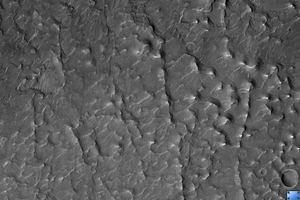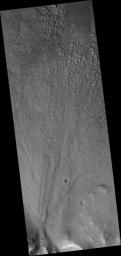
Click on image for larger versionThis HiRISE image (PSP_003269_1600) covers an alluvial fan along the wall of a large crater in the mid latitudes of the southern hemisphere of Mars.
The fan was formed when water and sediments drained down the steep wall of the crater creating a cone-shaped pile of debris at the base. As the fan grew with time, the channels carrying water and sediment across the fan surface changed locations, producing a layered deposit capped by channels radiating from the fan apex along the crater wall.
Subsequent stripping of the fan surface by the wind has left the coarser channel deposits in relief and exposed the fine scale layering within the fan in many locations. While is it is not known whether the source of the water responsible for creating the fan was related runoff from precipitation or groundwater or perhaps both, alluvial fans of broadly similar form are observed in many locations on Earth and are usually formed by runoff from precipitation.
Observation Toolbox
Acquisition date: 4 April 2007
Local Mars time: 3:42 PM
Degrees latitude (centered): -19.9°
Degrees longitude (East): 123.2°
Range to target site: 258.6 km (161.6 miles)
Original image scale range: 25.9 cm/pixel (with 1 x 1 binning) so objects ~78 cm across are resolved
Map-projected scale: 25 cm/pixel and north is up
Map-projection: EQUIRECTANGULAR
Emission angle: 4.7°
Phase angle: 48.6°
Solar incidence angle: 53°, with the Sun about 37° above the horizon
Solar longitude: 215.1°, Northern Autumn
NASA's Jet Propulsion Laboratory, a division of the California Institute of Technology in Pasadena, manages the Mars Reconnaissance Orbiter for NASA's Science Mission Directorate, Washington. Lockheed Martin Space Systems, Denver, is the prime contractor for the project and built the spacecraft. The High Resolution Imaging Science Experiment is operated by the University of Arizona, Tucson, and the instrument was built by Ball Aerospace and Technology Corp., Boulder, Colo.

 Planetary Data System
Planetary Data System













